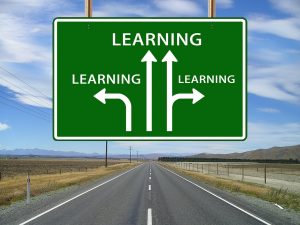The Many Pathways to Knowledge
Learning Goals
In this chapter, you will learn to:
- Use pre-reading strategies
- Use the five W questions to check your understanding while you read
- Build your vocabulary
- Understand the main ideas, details, and sequence of a text
- Spell common homonyms
- Use apostrophes in contractions
- Identify and correct sentence fragments
- Write a how-to paragraph
Get Ready to Read
Think about the questions below or discuss them with a partner.
- Think of a time when you struggled to learn something new. What helped you to cope?
- Are some people born smart or do they become that way through practice?
- What do you already know about learning disabilities?

Reading Strategy
Readers check their understanding of a text while they read. One strategy is to stop a few times in the text to ask yourself: Can I answer any of the five W questions: who, what, where, when, or why? If you are able to answer at least three of these questions, then you are thinking about what you are reading.
Try this strategy as you read The Many Pathways to Knowledge.
Vocabulary
Find these words in the text. Use the context to choose the best meaning.
| decade | factors | affect | learning disability | dread |
| exercise | peer | clumsiness | pace | approach |
1. A condition that makes learning difficult is called a ___________________________.
2. ___________________________ means moving in a way where you might drop or break things.
3. A ___________________________ is one of the things that cause something to happen.
4. ___________________________ refers to activity that is done to be healthier.
5. Another word for 10 years is a ___________________________.
6. ___________________________ is the speed at which something happens.
7. ___________________________ means to act on or cause a change in someone or something.
8. ___________________________ means to fear that something will happen.
9. A person in the same age group or social group can be called a ___________________________.
10. An ___________________________ is a way of dealing with something.
Check your Understanding
1. Read the sentences below. Which group of sentences best describes the main idea of the text?
a. Barbara Arrowsmith-Young taught herself to tell time, do math, understand grammar, and be less clumsy.
b. Geniuses aren’t born being great at something. They become geniuses through practice. People with learning disabilities can also be great at the thing they struggle with. They just learn in a different way and at a different pace.
2. Re-read the second paragraph. What is the main idea?
3. Put these events in the correct sequence.
a. After lots of practice, Barbara was able to do the things her brain was “unable” to do.
b. Barbara’s teachers said she had a learning disability.
c. Barbara made exercises to teach her brain to do the things it couldn’t.
d. Barbara struggled to learn many of the things taught in elementary school.
e. Barbara started a school to help others who learn in different ways.
f. As an adult, Barbara learned that people can change the structure of their brain through experience and exercise.
4. Try to think of the best word to complete each sentence.
a. Geniuses usually practiced their skill ___________________ hours a week for over a decade.
b. We will have a hard time learning if we do not get enough ______________________ food to eat.
c. Barbara’s teachers said she had a learning ______________________.
d. Barbara heard that people can change their brains through _________________ and ___________________.
e. She created exercises to teach herself to tell ________________________.
f. Afterward, she could also understand the rules of _____________________ and ____________________________.
g. We can change the ________________________ of our brains through practice.
Spelling
Homonyms are two words that sound the same but have different meanings. Study these homonyms. Arrange a date to be tested on your ability to spell these words. One way to learn to spell words is to use memorable sentences. If you can remember which spelling goes with which homonym in these sentences, you can use the information to help you spell the homonyms correctly in other sentences.
Affect: to act on or change something. Affect is usually used as a verb.
Effect: a change that results from something else. Effect is usually used as a noun.
- The asteroid affected the apartment.
- The effect was eerie.
Their: used to show possession.
They’re: used as a contraction meaning “they are.”
There: used to refer to a place.
- They said they’re sorry for leaving their thumbtacks there.
Whether: shares a similar meaning with “if.”
Weather: usually refers to the temperature, rain, wind, and so on.
- I don’t know whether this rainy weather will end.
Its: used to show possession, like “his” and “her.”
It’s: the contraction for “it is” or “it has.”
- It’s time for the lion to show its cubs how to hunt.
Do these sentences use the correct homonym? If not, change them.
1. I wonder what the whether will be like today.
2. Can you put this box down over there?
3. It’s too late at night to practice playing my bagpipes.
4. All the unions decided that they’re going on strike.
5. My shirt is missing most of it’s buttons.
6. Does this medicine have any side affects?
7. The big flood in the town did not effect my house.
8. My parents are selling me their old car.
9. I don’t know weather I should drive in this snow.
Apostrophes in Contractions
Grammar Rule
An apostrophe is used in place of the missing letter or letters in a contraction.
- We often think people are either born smart or they aren’t.
Aren’t = are not
- Intelligence is not something we either have or we don’t have.
Don’t = do not
- People who thought they couldn’t learn have found out they can.
Couldn’t = could not
Change the underlined words into contractions. Use apostrophes as needed.
1. We do not tend to remember our dreams unless we wake up during them.
2. It is easiest to learn a second language between the ages of 13 and 20 years old.
3. You will likely find that the best way to break a bad habit is to replace it with a new one.
4. Studies show that you should not stay up late cramming for a test because sleep is key to learning.
5. You would never be able to learn without neurons.
6. When a baby is 24 months old, she will know that the person in the mirror is herself.
7. A child who does not hear any words or language before 12 years old will not learn to speak.
8. Alan Turing was a computer scientist. In the 1950s, he came up with the Turing Test, a way to tell if a computer is intelligent. To do the test, you sit someone at a screen that is connected either to a computer or another person in a different room. The person chats and asks questions to discover whether they are talking to a computer or a person. If they cannot tell the difference, and it is a computer they are talking to, the computer can be called “intelligent.” Some people say that a computer passed the test for the first time in 2014.

Sentence Fragments
A complete sentence needs three things: a subject, a verb, and a complete thought. If a sentence is missing one of these, it is called a sentence fragment.
Grammar Rule
Sentence fragments are a common mistake in people’s writing.
- This sentence is missing a subject: Is the smallest country in the world.
Fixed: Vatican City is the smallest country in the world.
- This sentence is missing a verb: Mount Etna Europe’s tallest active volcano.
Fixed: Mount Etna is Europe’s tallest active volcano.
- This sentence is missing a complete thought: Average drivers spend two weeks of their life.
Fixed: Average drivers spend two weeks of their life waiting for traffic lights to change.
Are these complete sentences or fragments?
1. A boy.
2. Typed the English alphabet on an iPad.
3. In less than six seconds.
4. Astronauts say space has a unique smell.
5. Hit by lightning.
6. Barbie’s full name is Barbara Millicent Roberts.
7. Daniel Radcliffe wore 160 pairs of glasses while filming the Harry Potter movies.
8. An artist from Chicago.
9. Made a statue of Madonna using 180 pounds of ham.
What is missing from these sentence fragments — a subject, verb, or complete thought?
10. Is on Facebook.
11. The average Facebook user has.
12. Dyed his sheep bright orange to prevent theft.
13. Is 5 feet 11 inches.
14. A calf in Virginia.
15. Erin Finnegan and Noah Fulmor.
16. Was born with a five-foot long tail.
17. One in every seven people on Earth.
18. The average height of the Dutch.
19. 190 friends.
20. Over 70 species of mushrooms.
21. A British farmer.
22. Glow in the dark.
23. Became the first couple to get married in outer space.
24. Each sentence fragment above can be matched to another sentence fragment above to make a complete sentence. Find the fragments that go together to make a complete sentence. Use them to write a complete sentence.
Writing
How-to paragraphs give directions. For example, this kind of paragraph might explain how to plant a tree, how to make a campfire, or how to send an email.
A how-to paragraph should:
- Begin with a topic sentence that says what task you are explaining
- Break the task down into small steps
- Explain each step clearly
- List the steps in the order the reader should do them
- Use linking words like first, then, next, after that, and finally
Below is an example of a how-to paragraph. Underline the topic sentence, the linking words, and the concluding sentence.
How to Trim a Dragon’s Toenails
People are often afraid to clip the toenails of a dragon, but it’s really not that hard. First, gather all the things you will need: nighttime tea, a tea cup, hedge trimmers, a bumpy rock, and some nail polish. Then, make the dragon a warm cup of nighttime tea. After the dragon drinks the tea, he will fall asleep. Next, pick up the hedge trimmers and carefully cut the top two inches of each toenail. After that, rub the rock back and forth over the edge of each toenail until it is nice and smooth. You may also wish to apply a coat of nail polish. Most dragons prefer red nail polish, but some dragons prefer purple. Finally, run away as fast as you can. The dragon will wake up soon, and you don’t want to be there when he does. Follow these steps and the dragon’s toenails will look fabulous!

Writing Task
Think about a challenge you have faced in your life, especially one you managed well. The challenge might be something practical, like changing a tire. The challenge may be something complex, like moving to a new country or coping with a divorce. Write a how-to paragraph to help someone who is facing the same challenge you faced.
Follow the TOWER method to write your paragraph. First, think of some challenges that you handled well. Choose one that you feel good writing about. Next, use the How To paragraph planner to brainstorm and organize your ideas. Then, write a first draft. Remember to include a topic sentence, linking words to smoothly connect each step, and a concluding sentence. Edit the paragraph with the help of your instructor and The Many Pathways to Knowledge paragraph planner checklist. After that, rewrite the paragraph. You may wish to type it on a computer. Finally, hand it in to your instructor.
Ask your instructor for copies of the paragraph planners, or print copies from the links above. For printable versions, see Appendix 1 and Appendix 2.
Did you notice that the above paragraph looks a lot like a how-to paragraph?
Answer Key
| Vocabulary | |
| QUESTION | ANSWER |
| 1 | learning disability |
| 2 | clumsiness |
| 3 | factor |
| 4 | exercise |
| 5 | decade |
| 6 | pace |
| 7 | affect |
| 8 | dread |
| 9 | peer |
| 10 | approach |
| Check Your Understanding | |
| QUESTION | ANSWER |
| 1 | b |
| 2 | Many different factors affect how well we learn. |
| 3 | d, b, f, c, a, e |
| 4a | 20 |
| 4b | healthy |
| 4c | disability |
| 4d | experience and exercise |
| 4e | time |
| 4f | math and grammar |
| 4g | structure |
| Spelling | |
| QUESTION | ANSWER |
| 1 | I wonder what the weather will be like today. |
| 2 | This sentence is correct. |
| 3 | This sentence is correct. |
| 4 | This sentence is correct. |
| 5 | My shirt is missing most of its buttons. |
| 6 | Does this medicine have any side effects? |
| 7 | The big flood in the town did not affect my house. |
| 8 | This sentence is correct. |
| 9 | I don’t know whether I should drive in this snow. |
| Apostrophes in Contractions | |
| QUESTION | ANSWER |
| 1 | We don’t tend to remember our dreams unless we wake up during them. |
| 2 | It’s easiest to learn a second language between the ages of 13 and 20 years old. |
| 3 | You’ll likely find that the best way to break a bad habit is to replace it with a new one. |
| 4 | Studies show that you shouldn’t stay up late cramming for a test because sleep is key to learning. |
| 5 | You’d never be able to learn without neurons. |
| 6 | When a baby is 24 months old, she’ll know that the person in the mirror is herself. |
| 7 | A child who doesn’t hear any words or language before 12 years old won’t learn to speak. |
| 8 | Alan Turing was a computer scientist. In the 1950s, he came up with the Turing Test, a way to tell if a computer is intelligent. To do the test, you sit someone at a screen that’s connected either to a computer or another person in a different room. The person chats and asks questions to discover whether they’re talking to a computer or a person. If they can’t tell the difference, and it’s a computer they’re talking to, the computer can be called “intelligent.” Some people say that a computer passed the test for the first time in 2014. |
| Sentence Fragments | |
| QUESTION | ANSWER |
| 1 | fragment |
| 2 | fragment |
| 3 | fragment |
| 4 | complete sentence |
| 5 | fragment |
| 6 | complete sentence |
| 7 | complete sentence |
| 8 | fragment |
| 9 | fragment |
| 10 | subject |
| 11 | complete thought |
| 12 | subject |
| 13 | subject |
| 14 | verb and/or complete thought |
| 15 | complete thought |
| 16 | subject |
| 17 | verb |
| 18 | verb |
| 19 | verb and/or complete thought |
| 20 | verb and/or complete thought |
| 21 | verb and/or complete thought |
| 22 | subject |
| 23 | subject |
| 24 | The average Facebook user has 190 friends. |
| A British farmer dyed his sheep bright orange to prevent theft. | |
| A calf in Virginia was born with a five-foot long tail. | |
| Erin Finnegan and Noah Fulmor became the first couple to get married in outer space. | |
| One in every seven people on Earth is on Facebook. | |
| The average height of the Dutch is 5 feet 11 inches. | |
| Over 70 species of mushrooms glow in the dark. | |
| Writing | |
| People are often afraid to clip the toenails of a dragon, but it’s really not that hard. First, gather all the things you will need: nighttime tea, a tea cup, hedge trimmers, a bumpy rock, and some nail polish. Then, make the dragon a warm cup of nighttime tea. After the dragon drinks the tea, he will fall asleep. Next, pick up the hedge trimmers and carefully cut the top two inches of each toenail. After that, rub the rock back and forth over the edge of each toenail until it is nice and smooth. You may also wish to apply a coat of nail polish. Most dragons prefer red nail polish, but some dragons prefer purple. Finally, run away as fast as you can. The dragon will wake up soon, and you don’t want to be there when he does. Follow these steps and the dragon’s toenails will look fabulous! | |
Attributions
Learning
Image by geralt is in the public domain.
Alan Turing
Allan Turing, Bletchley Park by Beyond My Ken is used under a CC BY SA 3.0 license.
Green dragon
Image by PublicDomainPictures is in the public domain.

